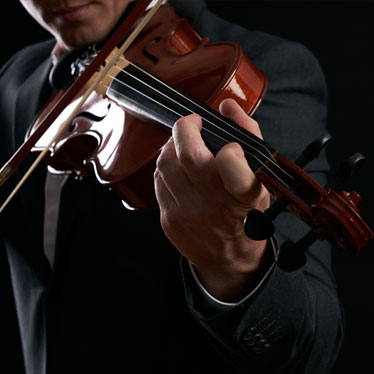15-Minute Performance Warm-Up For You And Your Violin

Of all the aspects involved in playing violin, one of the most neglected is the warm-up routine. Both you and your instrument need to prepare before practice or a performance. If not, you can risk injury or damages, and the odds of harming yourself or your violin increase with age. However, by developing a warm-up routine now (and making sure to do it every time you play), you’ll extend the years you can play and protect your valuable instrument.
Basically, any warm-up session that goes longer than 15-minutes actually turns into a practice, so you’ll want to keep it simple and specific. You should remember too, that this information is a guideline. Every musician will create their own variations to suit their unique playing style and tastes. This example is simply an outline to get you started.
Start by making sure your instrument is warm
If you’ve been traveling all day and just got to the venue, your organic instrument needs time to acclimate to the surroundings. As long as you’ve kept it warm (or cool) inside the vehicle while traveling, open the case and let it rest while you perform some stretches and exercises to help you limber up your joints and muscles. If your instrument has gotten cold, you’ll need to wait a few hours before attempting to warm up. Try to raise the temperature slowly, like bringing it into the garage first, then into the warm house.
You can also warm up new strings by using a specific technique described in this short video. It will ensure that your strings don’t quickly lose pitch while you’re playing, and it extends the life of new strings.
Once Your Instrument is Ready: 7-Minutes
All string musicians should perform limbering exercises before playing. There are tons of easy, healthy actions that will ensure that your joints are ready to move. In the same way an athlete would prepare to run a race, stretches and other agility exercises will help you prevent sprains or muscle cramps. Some of the best include:
- Basic Yoga Poses—Even if you’ve never tried these poses, they are really fun and effective for musicians. The nature of playing the instrument is not ergonomic, which means that your body is under stress. Because Yoga is used as a holistic therapy for all sorts of overuse injuries and for increasing circulation, adding these simple stretches to your warm-up is an excellent way to ward off a number of common complaints like repetitive motion injuries in your neck, wrist, or shoulder.
- Easy Stretches—These involve increasing flexibility. Some simple ones include spreading your fingers as far as you can and holding it for a count of two, then squeezing them together. Or, try laying your hand on a flat surface and then gently lift each finger as far as possible and hold it for the 1-2 count before laying it back down. Don’t forget to stretch your rotator cuff and wrist. With all the bowing required, this is invaluable during warm up. Click here to see basic shoulder, back, and neck stretches to add to the 7-minute segment.
Fingering and Bowing Drills: 8-Minutes
This is where all your previous practice comes in handy. You’ll want to perform these drills slowly. The point of the entire process is to warm up your body, not immediately start playing. Some great starter ideas include:
- Slow Trills—Do this one string at a time and use minimal pressure.
- Sevcik etudes—These will deliver a full range of finger patterns. Again, working slowly, perform a few to help prepare for the practice or playing session.
- Scales and Arpeggios—Major and minor ones are good to run through, but don’t use vibrato, just warm up slowly, with minimal pressure.
- Bowing—The only thing you need to add here is to remember to warm up with long, slow bow strokes using even slurring.
The whole point of doing a 15-minute warm up is to make it easier on your muscles and joints when you’re performing or practicing a really difficult piece. Take your time, use light pressure and full extension on the bow. It can help if you dedicate a specific minute or two to each element you want to add to your personal warm up routine.
Remember, all of these ideas are simply a rough outline. You may find that adding extra time doing stretches is best, or someone else might prefer to do more fingering drills. Regardless of your personal preference, regularly warming up your body and your violin will help prevent damages to both. Whatever works best for you, and is something that you will enjoy doing before each practice, is the best 15-minute warm-up plan.
This article sponsored by Thomastik-Infeld


